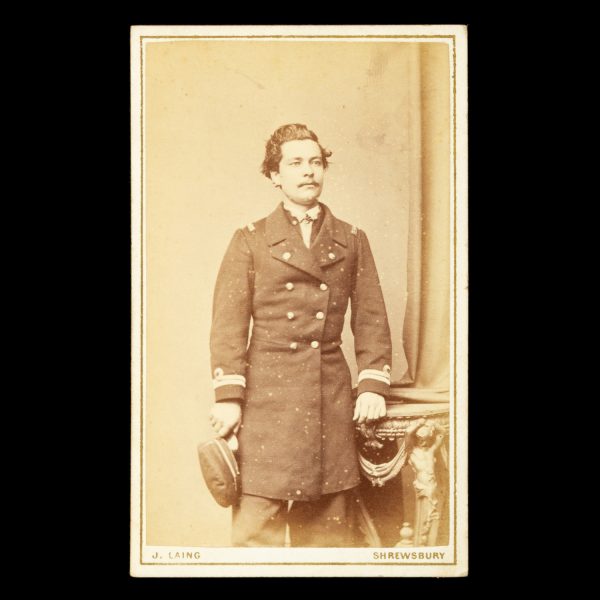# 46765
STANLEY, Henry Morton [ROWLANDS, John]
[AMERICAN CIVIL WAR] Henry Morton Stanley : a rare studio portrait of the African explorer in his Union naval uniform, taken during his service on USS Minnesota in late 1864 or early 1865.
$3,000.00 AUD
Albumen print photograph (a copy print made in 1872 from a print made by an unidentified American studio in 1864-65), carte de visite format, 103 x 63 mm (mount); verso with imprint of ‘J. Laing, Portrait & Landscape Photographer, Miniature & Portrait Painter. Castle Street, Shrewsbury’, and with an inscription in ink by the original owner ‘J. Prettey, August 9 [18]72’ and a roughly contemporary inscription in pencil identifying the sitter as ‘Livingstone’s Discoverer, Stanley’; in very good condition.
A rare and important portrait documenting part of the American military career of Henry Morton Stanley – possibly the only man to have served in the Confederate Army, the Union Army and the Union Navy during the Civil War.
Eighteen-year-old Welsh cabin boy John Rowlands arrived in New Orleans in the spring of 1859, and immediately experienced a sense of liberation from the British class system. Whether or not young Rowlands was indeed re-baptised and adopted by New Orleans cotton merchant Henry Hope Stanley has been the subject of much conjecture; however, he proceeded to take on a new identity in America, abandoning the name Rowlands and re-naming himself in honour of his new mentor.
In 1861, with some reluctance and partially out of fear of being branded a coward, Stanley enlisted in the Confederate army in Little Rock, Arkansas. He was attached to the 6th Arkansas Volunteer Regiment. In April 1862 he was captured by Union troops at the Battle of Shiloh, and incarcerated at Camp Douglas, near Chicago, where the mortality rate for prisoners was one in seven. After less than two months of imprisonment in atrocious conditions, Stanley was offered the chance of release in exchange for recruitment into the Union army; unsurprisingly he accepted, and was recruited on 4 June 1862. His stint in the Union land army was to be very brief, however: he was discharged 18 days later due to severe illness. When his health recovered, he served for a lengthy period on a number of merchant ships, before joining the US Navy in July 1864.
During his service as a record keeper on USS Minnesota, Stanley took part in several actions that included the First Battle of Fort Fisher (23 – 27 December 1864) and the Second Battle of Fort Fisher (13 – 15 January 1865). Another photographic studio portrait of him, quite possibly taken in the same studio at the same time as the one offered here, was reproduced as Figure 2 on page 278 of the April, 1918 issue of Geographical Review, in an article by Edwin Swift Balch, American Explorers of Africa (Geographical Review, Vol. 5, No. 4, pp. 274-281). The text of the caption below the illustration reads: ‘Henry M. Stanley in the United States Navy uniform he wore at the capture of Fort Fisher, January 15, 1865.’ (The relevant page in this publication has been digitised, and can be viewed at https://www.jstor.org/stable/207420?seq=5 )
Stanley jumped ship in Portsmouth, New Hampshire on 12 February 1865, effectively ending his contribution to the Union cause some eight weeks before General Robert E. Lee’s surrender at Appomattox on 9 April 1865.
Photographs of Stanley taken during his American years are exceedingly rare. Two cartes de visite – including one of Stanley in his USS Minnesota uniform, inscribed by him – were sold by Christie’s, London, in 2002 for GBP 3,585 (The African Sale including Henry Morton Stanley Collection, 23 September 2002, lot 5).
We have not been able to trace another example of the carte de visite of Stanley offered here. It is a copy print made in 1872 – the year Stanley achieved everlasting fame for finding Livingstone at Ujiji – by Shropshire photographer J. Laing, Shrewsbury, from an original made in 1864-65 by an unidentified American studio. We believe that the original may have been sent home from America in 1865 by Stanley to family or friends in Denbigh (a town in north Wales situated just 50 miles from Shrewsbury), where Stanley had spent part of his early life in the care of his mother’s family, the Parrys, and that in the first part of 1872 it was taken to Laing’s studio in Shrewsbury where a small number of copies were made for private circulation only.











